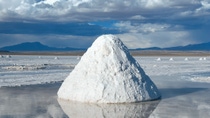Who we are
A very special compound
Salt is much more than just a condiment. And food is not the only thing that needs a pinch of salt: It is also found in soap, glass and plastic containers.

Careful – it’s easy to get confused. Have you ever had to spit out your first sip of coffee in the morning because you accidentally added salt instead of sugar? But aside from taste, what does salt have that sugar doesn’t, even though the two look so similar?

Salt’s electrostatic forces are what make it a very special raw material in all its forms and facets. When we talk about salt in an everyday context, we mean sodium chloride, also known as table salt. But from a chemistry perspective, it is just one of many salts, since “salt” covers all of the ionic solid compounds. They often form stunning crystal shapes, but not every crystal is a salt.
Each salt has a positive and a negative charge and thus the desire to bond. This property is what makes salt so multi-talented. For example, in the bathroom, where salt in the form of soap (in chemistry terms, the sodium and potassium salts of fatty acids) is waiting to bind with the fats on our skin and the particles of dirt they contain. It is also practical that some plant pigments are just as eager as salt to make electrostatic bonds – the red wine stain on the flokati rug becomes invisible when rubbed with salt because the salt and the pigment are attracted to each other.
“On average, our bodies contain 150 – 300 grams of sodium chloride. Without salt we would be unable to live.“
Not all salt is the same
Salts can be white or colorful, like the purple-colored potassium permanganate which is used in deodorants because of its disinfectant properties. Salts can taste spicy, such as ammonium chloride, a component of salty licorice. Or salts can also taste sweet, like lead acetate (also known as lead sugar) which is poisonous but was nevertheless used as a sweetener until the 19th century. Some salts are even highly toxic, such as potassium cyanide, which is used in gold extraction.
The best-known salt is sodium chloride. But around 95 percent of global table salt production does not end up on our table – instead, it is used as an industrial raw material for numerous products, ranging from aluminum to pulp.
Salt has very special properties when it is moving, i.e., in liquid form. “Ionic liquids are made up of electrically charged molecules,” explains Professor Barbara Kirchner from the Mulliken Center for Theoretical Chemistry at the University of Bonn, Germany. Surprising reactions are possible in these kinds of liquids. “From the various combinations of molecule ions, you can get an endless variety of new liquids,” the researcher explains. “Right now, for example, research is being done into their energy storage properties in the field of lithium-air batteries.” And in solar thermal energy, ionic liquids play an important role as heat storage media.

Enjoy in moderation
No living creature is able to survive without the physiological functions of salt. On average, our bodies contain 150 – 300 grams of sodium chloride. Whatever salt we lose by flushing out or by sweating, we have to replace through our food consumption – as a rule, up to 6 grams per day. This is because sodium ions act as a sort of universal regulator in our bodies: They are vital for nerve and muscle function and for regulating our hydration and blood pressure. Without salt we simply would be unable to live. The astounding thing is that only a factor of 20 separates the amount that is physiologically necessary and a fatal dose. If a person consumes around one gram of salt per kilogram of body weight in a day, depending on his or her physical condition there is a 50 percent chance that the person will die. An adult weighing 60 kilograms can therefore die by consuming around 60 grams of salt within 24 hours; for a small child weighing 15 kilograms, a deadly dose could be just a large tablespoon with 15 grams.
